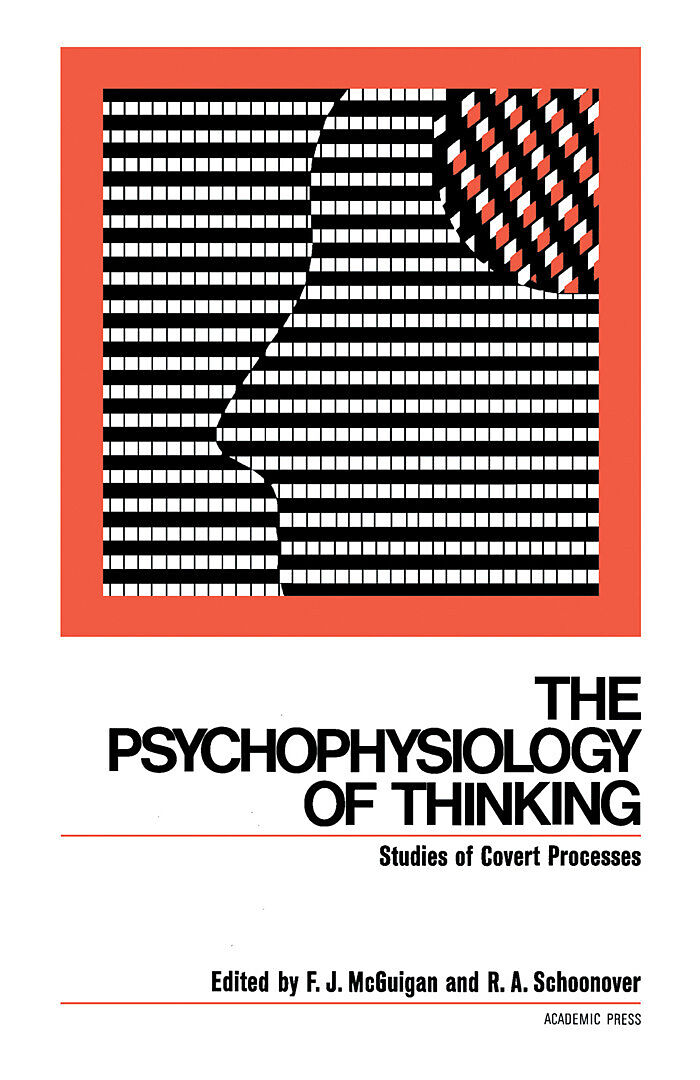The Psychophysiology of Thinking
Format:
E-Book (pdf)
EAN:
9780323147002
Untertitel:
Studies of Covert Processes
Genre:
Psychologie
Herausgeber:
Elsevier Science & Techn.
Anzahl Seiten:
528
Erscheinungsdatum:
02.12.2012
The Psychophysiology of Thinking: Studies of Covert Processes describes the relation between brain events and peripheral bodily phenomena in the context of psychological theory. This book is organized into six parts encompassing 14 chapters, which focus on higher mental processes.
This book starts with the historical development of electrical measures of covert processes. The subsequent chapters discuss the mechanism of conditioning of central nervous system, the skeletal musculature, and the autonomic activity. Other chapters explore the principles of hallucinations, sleep and dreaming, imagery, biofeedback, evoked potentials during thought, meaning, and thought with concomitant measures. The remaining chapters emphasize cerebral mechanisms, which principal concern is with the involvement of other bodily mechanisms in thought.
Psychophysiologists, neurobiologists, behaviorists, and researchers in the fields of thinking and covert processes will find this book invaluable.
Inhalt
List of Contributors
Preface
Introduction
1. Electrophysiology of Mental Activities and Introduction to the Psychological Process of Thinking
The Discussion of Dr. Jacobson' s Paper
Open Discussion
References and Supporting Publications
Emphasis on Central Nervous System-Primaryil Electroencephalogmra
2. The Operant Conditioning of the Electrical Activity of the Brain as a Method for Controlling Neural and Mental Processes
I. Introduction
II. The Processes Controlled by Operant Neural Conditioning
III. Operant Neural Conditioning as a Method of Control
IV. Efficiency of Conditioning: Feedback and Constraints on Conditioning
V. Operant Neural Conditioning as a Method for Studying Functional Significance
VI . Conclusion
The Discussion of Dr. Black's Presentation
Open Discussion
References
3. Evoked Potentials of the Brain Related to Thinking
I. Experimental Design
II. Average Evoked Potential from One Subject
III. Analysis of Group Data
IV. CNV and AEP
V. AEP Changes with Learning
VI. Discussion
VII. Conclusions
References
The Discussion of Dr. Chapman's Paper
Open Discussion
References
4. Objective EEG Methods for Studying Covert Shifts of Visual Attention
I. Introduction
II. Neurophysiological Basis for Changes in the EEG Related to Visual Attention
Open Discussion
References
5. The Psychophysiology of Mental Activity during Sleep
I. Description of the Stages of Sleep
II. Relationship of Mental Activity to Sleep Stages
III. Temporal Correlates
IV. EEG Correlates
V. Motor Activity
VI. Cardiac and Respiratory Activity
VII. Electrodermal Activity
VIII. Penile Erections
IX. Temperature
X. Sympathetic Arousal
XI. Eye Movement Activity
XII. Phasic Events
XIII. Phasic Events and Other Physiological Variables
References
The Discussion of Dr. Rechtscharfen' s Paper
Open Discussion
References
Emphasis on Central Nervous System-Primarily Surgical Approachase
6. Lateral Specialization of Cerebral Function in the Surgically Separated Hemispheres
The Discussion of Dr. Sperry's Paper
Open Discussion
References
Emphasis on Peripheral Measures-Primarily Autonomic Behavior
7. The Role of Consciousness and Cognition in Autonomic Behavior Change
The Discussion of Dr. Grings's Paper
Open Discussion
References
8. Psychophysiological Correlates of Imagery
I. Theoretical Definition of Imagery
II. Electroencephalographic Studies
III. Eye Movements and Imagery
IV. Pupillary Reactions during Imagery Tasks
The Discussion of Dr. Paivio's Paper
Open Discussion
References
Emphasis on Peripheral Measures-Primarily Electromyogram
9. Hallucinations: An Experimental Approach
I. Hypnotically Induced Hallucinations
II. Conditioned Hallucinations
The Discussion of Dr. Hefferline's Paper
Open Discussion
References
10. Electrical Measurement of Covert Processes as an Explication of "Higher Mental Events"
I. On the Genesis of the Problem of "Mind," and of a Natural Science
Approach to "Mental Processes"
II. Development of Experimental Techniques
III. Language Stimuli as an Indicator of Thinking
IV. Internal Information Processing
V. Measurement of Covert Oral Behavior
VI. Summary
VII. Systematic Changes in the Amplitude of Covert Oral Behavior
VIII. Summary and Preliminary Interpretation
IX. Study of Patterns of Covert Processes
X. Mediational Processes
XI. Concluding Statement
The Discussion of Dr. McGuigan's Paper
Open Discussion
References
11. Biofeedback Techniques and the Conditions for Hallucinatory Activity
I. Inferences about Consciousnes
II. Between Sleep and Wakefulness
III. On the Conditions for Hallucinatory Activity
IV. Summary of Argument
The Discussion of Dr. Stoyva's Paper
Open Discussion
References
Integrative Approaches
12. Central Processes Controlling Speech Production during Sleep and Waking
I. Lashley's Views on Serial Order in Behavior
II. Phoneme-Based Models of Speech Production
III. The "Motor Command" Hypothesis
IV. The "Target" Hypothesis
V. The Role of Sensory Feedback
VI. The Multiplicity of Functional Units
VII. The Implications of Speech Errors
VIII. An Hierarchical Schema for Speech Production
IX. A Contemporary Associative Chain Model
X. Speech Production during Sleep
XI. Subvocal Activity during Sleep
XII. Physiological Correlates of Sleep Talking
XIII. Language Behavior during Sleep: Further Questions
XIV. The Verbal Component of Dream Content
XV. Speech Errors in Sleep-Talking Episodes
The Discussion of Dr. MacNeilage's Paper
Open Discussion
References
13. Psychophysiological Correlates of Meaning: Essences or Tracers?
I. Two-Stage (Representational) Neobehaviorism
II. Universals of Affective Meaning
III. Three-Stage (Integrational) Neobehaviorism
IV. Central Versus Peripheral Facilitation of Perception
V. On the Nature and Nurture of Tracers of M
The Discussion of Dr. Osgood's Paper
Open Discussion
References
14. Final Open Discussion
Author Index
Subject Index

Leider konnten wir für diesen Artikel keine Preise ermitteln ...
billigbuch.ch sucht jetzt für Sie die besten Angebote ...
Die aktuellen Verkaufspreise von 3 Onlineshops werden in Realtime abgefragt.
Sie können das gewünschte Produkt anschliessend direkt beim Anbieter Ihrer Wahl bestellen.
Loading...
Die aktuellen Verkaufspreise von 3 Onlineshops werden in Realtime abgefragt.
Sie können das gewünschte Produkt anschliessend direkt beim Anbieter Ihrer Wahl bestellen.
| # | Onlineshop | Preis CHF | Versand CHF | Total CHF | ||
|---|---|---|---|---|---|---|
| 1 | Seller | 0.00 | 0.00 | 0.00 |
